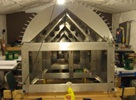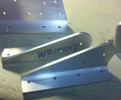


random user submitted photo
Battery and Alternator
6 posts
• Page 1 of 1
Battery and Alternator
Good Morning Everyone,
Those of you that have been reading my post over the last couple of months know that I use my new to me Sonex Aerovee as a "commuter plane". My commute is about 25 minutes flight time. Of this, only about 20 minutes is spent with the rpm's above 2500. My five year old Odeyssey PC625 battery gets drained after two or three starts.
I believe a contributing factor to this is the age of the battery, so I have just ordered a new one. In reading the forum, I have also learned that our alternators do not begin to charge until the rpm's get to about 2500. With my short commute, there is not much time for charging as only a portion of this time is spent over 2500 rpm.
Is there a modification that I can do that will allow charging to start at an rpm near idle?
Thank you,
Aldo
Those of you that have been reading my post over the last couple of months know that I use my new to me Sonex Aerovee as a "commuter plane". My commute is about 25 minutes flight time. Of this, only about 20 minutes is spent with the rpm's above 2500. My five year old Odeyssey PC625 battery gets drained after two or three starts.
I believe a contributing factor to this is the age of the battery, so I have just ordered a new one. In reading the forum, I have also learned that our alternators do not begin to charge until the rpm's get to about 2500. With my short commute, there is not much time for charging as only a portion of this time is spent over 2500 rpm.
Is there a modification that I can do that will allow charging to start at an rpm near idle?
Thank you,
Aldo
Aldo / Sonex #0954
TriGear/ Aerovee
Southport, NC
TriGear/ Aerovee
Southport, NC
- Aldo
- Posts: 31
- Joined: Mon Aug 25, 2014 2:25 pm
Re: Battery and Alternator
25 minutes of charging in flight should top off your battery.
I suspect you aren't charging. Do you have an ammeter? Or monitor voltage?
With my Jabiru, I start producing AMPS at around 2500 rpm and see around 3 AMPs being sent to the battery. Voltage jumps to 14.3V when its charging. If I turn off the alternator in flight, voltage drops to 12.2 V which is what the battery has left in it and what I see taxiing around and with the engine off.
If you are charging, then it must be your battery is end of life.
I suspect you aren't charging. Do you have an ammeter? Or monitor voltage?
With my Jabiru, I start producing AMPS at around 2500 rpm and see around 3 AMPs being sent to the battery. Voltage jumps to 14.3V when its charging. If I turn off the alternator in flight, voltage drops to 12.2 V which is what the battery has left in it and what I see taxiing around and with the engine off.
If you are charging, then it must be your battery is end of life.
John Gillis
SEL Private, Comm Glider, Tow pilot (Pawnee Driver)
Waiex N116YX, Jabiru 3300, Tail dragger,
First flight, 3/16/2013. 403 hours and climbing.
Home: CO15. KOSH x 5
Flying a B-Model Conversion (Super Bee Baby!)
-

fastj22 - Posts: 1594
- Joined: Sun Aug 21, 2011 5:56 pm
- Location: Mile High
Re: Battery and Alternator
Aldo,
While a five year old battery may be near its end of life, I don't think a new battery is going to help you much. The permanent magnet alternator on an Aerovee only deliver enough amps to recharge at higher RPM's. I collect the data stream from my Enigma for all my flights and it shows a pretty consistent voltage curve during my flights.
The data show that it takes at least 45 minutes to recharge the battery with RPM's in the 3000 range. If you have a voltage display available in flight, I would track the change in voltage over the course of your flights. You would like to see the voltage come up to at least 14 volts (assuming your measuring device is calibrated, about 1 volt increase from the start of the flight if not). If you get up to around that number you know your battery is mostly finished filling up.
My time listed above is with an Aerovee 2.0 and the 20 amp alternator, if you have the 10 amp alternator your recharge time will probably be longer.
Specific things you could try. Do one flight at normal cruise RPM's measuring your voltage, and do another at WOT. You will get a quicker rise at 3300 to 3400 RPM than you will at 3000 to 3100. Also, while monitoring voltage in cruise, turn off your secondary ignition for one flight during cruise and see if that makes a difference (there are a few Aerovee flyers who regularly fly this way). Depending on what electrical devices you have in your plane, it might be the highest drawing device you have. Lights, especially non LED lights would be the other high draws.
The PC625 will take all the amps you can throw at it with no worries. So turn off any other high current devices that you don't require and it will gobble up those amps. If none of this helps, and I suspect it won't help much, and you have access to power when your aircraft is at its home base, hook it up to a smart charger every night. Your battery will thank you and I'm sure you will have enough juice in the battery to make one remote start to come home.
While a five year old battery may be near its end of life, I don't think a new battery is going to help you much. The permanent magnet alternator on an Aerovee only deliver enough amps to recharge at higher RPM's. I collect the data stream from my Enigma for all my flights and it shows a pretty consistent voltage curve during my flights.
The data show that it takes at least 45 minutes to recharge the battery with RPM's in the 3000 range. If you have a voltage display available in flight, I would track the change in voltage over the course of your flights. You would like to see the voltage come up to at least 14 volts (assuming your measuring device is calibrated, about 1 volt increase from the start of the flight if not). If you get up to around that number you know your battery is mostly finished filling up.
My time listed above is with an Aerovee 2.0 and the 20 amp alternator, if you have the 10 amp alternator your recharge time will probably be longer.
Specific things you could try. Do one flight at normal cruise RPM's measuring your voltage, and do another at WOT. You will get a quicker rise at 3300 to 3400 RPM than you will at 3000 to 3100. Also, while monitoring voltage in cruise, turn off your secondary ignition for one flight during cruise and see if that makes a difference (there are a few Aerovee flyers who regularly fly this way). Depending on what electrical devices you have in your plane, it might be the highest drawing device you have. Lights, especially non LED lights would be the other high draws.
The PC625 will take all the amps you can throw at it with no worries. So turn off any other high current devices that you don't require and it will gobble up those amps. If none of this helps, and I suspect it won't help much, and you have access to power when your aircraft is at its home base, hook it up to a smart charger every night. Your battery will thank you and I'm sure you will have enough juice in the battery to make one remote start to come home.
Bob Meyers
Built and Flying Sonex N982SX http://n982sx.com
Built and Flying RV-14 N626KM http://n626km.com
Built and Flying Sonex N982SX http://n982sx.com
Built and Flying RV-14 N626KM http://n626km.com
-

n982sx - Posts: 113
- Joined: Tue Sep 03, 2013 11:45 pm
- Location: Chicago, IL
Re: Battery and Alternator
Thank you gentlemen! As a pilot of certified aircraft - I don't get to do much of anything to the plane. So, I appreciate the education.
Aldo
Aldo
Aldo / Sonex #0954
TriGear/ Aerovee
Southport, NC
TriGear/ Aerovee
Southport, NC
- Aldo
- Posts: 31
- Joined: Mon Aug 25, 2014 2:25 pm
Re: Battery and Alternator
Replacing the battery is the quickest and probably cheapest first step (assuming your old battery is a few years old). My Odyssey is still strong and is probably 7 years old. Got it from an estate sale.
Another option would be to jump to one of the new lithium iron batteries. Twice the price, ¼ the weight, same voltage, but may provide a few more cycles before needing a charge.
Another option would be to jump to one of the new lithium iron batteries. Twice the price, ¼ the weight, same voltage, but may provide a few more cycles before needing a charge.
John Gillis
SEL Private, Comm Glider, Tow pilot (Pawnee Driver)
Waiex N116YX, Jabiru 3300, Tail dragger,
First flight, 3/16/2013. 403 hours and climbing.
Home: CO15. KOSH x 5
Flying a B-Model Conversion (Super Bee Baby!)
-

fastj22 - Posts: 1594
- Joined: Sun Aug 21, 2011 5:56 pm
- Location: Mile High
Re: Battery and Alternator
Fought the same battle with my Jab 3300 on Sonex 1051. Buy yourself a Odyssey battery charger and leave it plugged in when idle. The newer Jab 12 pole alternator is far better but the VW will likely continue to have trouble with long start cycles and short flights. My odyssey battery, and all other aircraft batteries, seem to have about a 3 to 5 year life span for most general aviation operators.
- petep
- Posts: 77
- Joined: Fri Apr 18, 2014 10:02 pm
6 posts
• Page 1 of 1
Who is online
Users browsing this forum: No registered users and 2 guests







